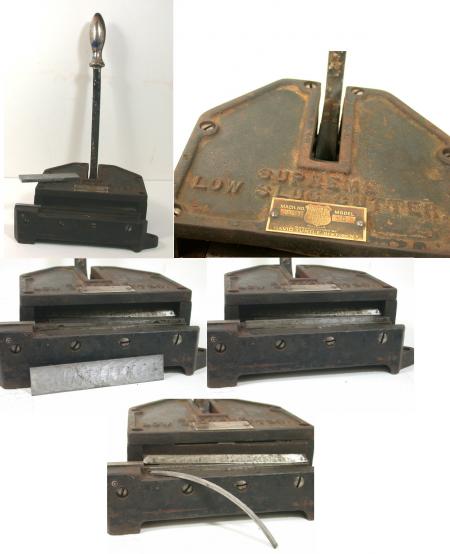Slug Cutter - sort of
I just got a slug cutter that does not cut leads and slugs to a specific length, in fact it does not cut them at all. what it does do, is cut strip material to type high. It cuts any length up to about 6 inches. you put the piece between two steel plates, pull the handle, the plates tighten and a blade comes out and slices off a bit and you’re left with a neatly cut lead or slug.
i can see using it if i’ve run out of leads and have extra rule. I’ve never seen one before - does anyone have any information on such a device and know if it has other uses?
Tomorrow, I’ll add pics. The top of the press has “…. Slug Cutter” so i’m sure that’s what it is.
Thanks - Charles

slugcutter.jpg
Pictures would help. Are you sure its not a mitering maching. Dick G.
Without seeing this gadget I would guess it’s a slug stripper. Cutting (stripping) the face of a rule, Linotype or Ludlow slug to .153, then double coated tape would affix this to regular slugs, or stereotype base at .765 to equal type high (.918). This stripper/tool was commonly used in the ‘60’s during the transition from hot type to paste-up cold type composition in many of the newspapers in the US and Canada!
I just uploaded a pic of the cutter. It’s showing the cutting of a 6 pt slug - I tried a linotype 12 pt slug and could not cut it. Also the top piece curls and distorts. Perhaps the cutter is dull. The use you describe seems the most reasonable. I’ll just use it to turn rules into leads.
Just when you think you’ve seen everything someone comes along with something like this. Never saw this before but Stanislaus got it right. Cool tool. Dick G.
Very cool! Love this stuff!
Thanks to my new orthopaedic shoes, I can, again, stand corrected. Upon seeing the photos, with “TURTLE” on the name plate, I’m convinced that, it is, in fact a slug stripper, something to strip rule or thin slugs to be used, as leads or slugs.
Turtle was a manufacturer, in possibly the 20’s, (long before the paste-up, cold-type transition) of line gauges, and some very neat, and very tough, very practical composing sticks. All of his products were marked with his International Typographical Union register number, and I believe mention of his membership in the New York ITU union.
A picture is worth a thousand words!
A rare find Charles, a great paperweight for your desk1
Stanislaus Pekala is right is tool was to remove the top image of the Linotype slug to place on a base. The layout man could move type around with the image for display ads in newspaper.
I used one in the 70’s, but it was saw that cut the top off and you pasted the line of type with the engraving for letterpress ads.
Also, I do not think you should print using type pasted on the base. It was used to make new reproduction proof for the camera department to shot.
I tried using a linotype slug, but there was no way this would cut lead this thick. I was able to cut 6 points max.
Maybe it is for cutting 6 pt. ludlow slugs. I can remember using a special saw to cut the ludlow slugs off to make minor corrections in ads at the newspaper. LikeAaron says this was done for a repro or to roll a mat from, taping a slug into a form could be dangerous. Dick G.
Aaron David: Please read my corrected comments of February 15th. You’ve quoted me on my comments of the 14th. On the 15th, after seeing photos of this tool, I’ve corrected my comments.Thank you and have a nice day!!
Charles,
Not exactly sure what is was meant to do. I have one also and have successfully used it to strip rule, wether straight edge, or scalloped or ornamental border, so that the length or the slug matches the length of the corresponding type it is set with, but the rule or ornamental design is trimmed to the desired length.
A little hard to describe, but picture a line that is set and the line below it has a rule that starts where the type above ends.
Sort of like you would have if you were creating a form.
Name___________
Address_________